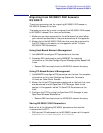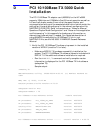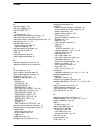
220 AppendixD
PCI 10/100Base-TX/3000 Quick Installation
2. Prepare system for hardware installation and access the system card
bay:
• Login with appropriate system management capabilities and
prepare system for shutdown (e.g., terminate any active jobs or
sessions, etc.)
• Issue a
<ctrl-a> shutdown. Make sure the system is halted before
continuing.
• When the system has shutdown completely, power off the system
by pressing the system off button. Unplug the system.
• Open the system to gain access to the PCI backplane, if
applicable.
• Select an empty PCI slot and remove the slot cover (if present).
3. Install the PCI 10/100Base-TX card:
• Observe the antistatic precautions.
• Record the serial number from the card, if present.
• Grasp the card by its edges or faceplate with both hands, insert
the card into the slot, and press the card firmly into place.
• Secure the card and retaining screws (if present). Reassemble the
system.
4. Attach the system to the network:
• Attach the 8-pin (RJ-45) plug on your twisted-pair LAN cable into
the RJ-45 connector on the card. The same RJ-45 connector is
used for either 10 or 100Mbit/s operation.
• Attach the free end of the cable to any unused port on the
appropriate hub or switch (or into a wall jack that is connected to
a hub or switch). Connect power to system. Set the hub or switch
speed and duplex mode. The PCI 10/100Base-TX card operates in
either full-duplex or half-duplex mode.
• Power up the system.
• Bring up the MPE/iX operating system.
5. Configure the link using NMMGR:
• Run NMMGR and open the network configuration file (e.g.,
NMCONFIG.PUB.SYS).
• Using “Guided Configuration”, configure or update the LAN
Configuration. Change an existing, or add a new Network
Interface (NI) so that the NI has a link Type of BT100, Enter the
Physical path of the LANIC so that it references the path of the
newly installed 10/100Base-T card.


















